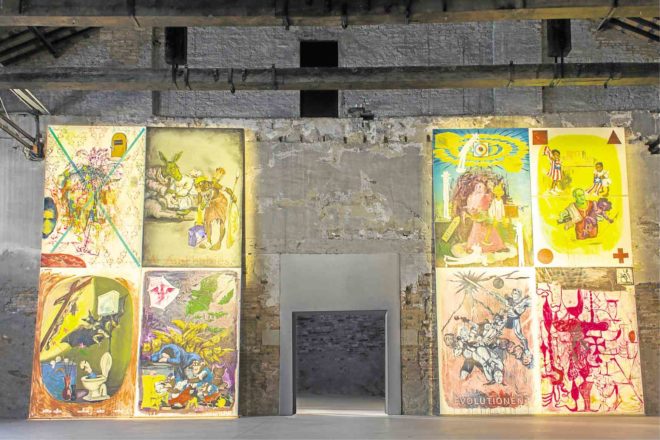
At the 57th Venice Art Biennale, our government scored a coup when the Philippine Pavilion landed in prime space. Located at the Artiglieri, an ancient artillery warehouse in the main venue, Arsenale, a former shipyard, the space was a generous 320 square meters or the size of a two-story house.
Despite November being the low tourist season, over 7,000 visited the pavilion on the Sunday before the art fair’s closing. The Philippines’ return to the world’s oldest art festival was a government initiative led by Sen. Loren Legarda, National Commission on Culture and the Arts, and Department of Foreign Affairs.
Venice Biennale has been known for conceptual art which rejects conventions of aesthetics and technique. Philippine representatives Manuel Ocampo, 52, and Lani Maestro, 60, followed the approach.
‘Comparisons’
Their works tackled universal issues such as racism, globalization and migrant labor.
Theme of the Philippine exhibit was “Spectre of Comparison,” which Philippine pavilion curator Joselina Cruz said was inspired by Jose Rizal’s “Noli Me Tangere.” When protagonist Crisostomo Ibarra visits the Manila Botanical Garden, he recalls his sojourn in Europe and draws comparisons between two worlds. Rizal’s original words were “el demonio de los comparaciones.”
“It’s about how our attitudes change when we come back to the Philippines. We have a bigger view of what the world can be,” Cruz explained.
On her choice of artists, Cruz told Lifestyle that she had seen the works of Ocampo and Maestro and read reviews about them abroad.
Ocampo travels around the world, works in a studio in Madrid but eventually comes home to Marikina. Maestro migrated to Canada and is now based in Normandy, France.
“Lani and Manuel are conceptual thinkers,” Cruz said. Their style eschews technique and beauty for concepts and issues.
Ocampo created two large murals of four quadrants, showing surrealistic satires of races, butts and innards.
“Torta Imperiales” was a cheeky allusion to the white race. One of the images was of a Pinoy band saying “Yes, sir,” “No, sir” to Americans to signify colonial subjugation.
Ocampo pointed out influences such as American cartoonist Robert Crumb’s anti-Chinese poster, abstractionist Rudolf Reinhardt, the Star of David, crosses, serpents and borders from the Russian Constructivist, “Master of the Universe” characters, and “Los Caprichos,” Spanish painter Goya’s take on universal folly.
Anting-anting symbols, Filipino komiks, his grandmother’s stories of ghouls, his fear of antique religious icons or santos, punk rock and surrealistic images from Spanish filmmaker Luis Bunuel also shaped his visual imagery.
“What is happening globally is what is happening in the Philippines. We can’t get stuck on an island. That is the specter of comparison. We have to think of the ghosts or devils outside of ourselves,” said Ocampo.
Maestro’s neon tubes were minimalist, albeit reduced to lines of poetry.
“I don’t make objects to sell. I’m interested in consciousness,” she said.
Language as image
Works included neon tubes that read: “No Pain Like This Body, No Body Like This Pain” and “If You Must Take My Life, Spare These Hands.” The tubes were handcrafted in Murano island, while the lighting was made by Neon Lauro, known for its centuries-old tradition in fabrication and neons in Conegliano, a historic town in the Veneto region.
Maestro is attracted to poetry and text as visual art.
“No Pain Like This Body, No Body Like This Pain” was based on the book by Indo-Caribbean émigré Harold Sonny Ladoo, whose patois or pidgin English fascinated her. She chose the title for a neon artwork as a subtle message on undermining violence.
In 2010, the neon message was displayed on a wall by the window of a gallery in a seedy neighborhood in Vancouver. “It brought art to the street,” she said.
Prostitutes, drug addicts and passers-by peered through the window. One woman, who was soaked in the rain, screamed the words.
“It’s amazing how language can function as image. It can travel from the wall to the window outside to the woman’s body,” said Maestro.
“If You Must Take My Life, Spare These Hands” was taken from the poem “Flowers of Glass” by New York-based writer Jose Perez Beduya. The neon signage was originally displayed in a castle, a former jewelry factory for luxury brands, in the South of France. It was done when the factory closed down and laid off workers.
The neon text referred to the value of the artisan’s hands as a means of livelihood.
Communal dimension
Maestro’s “Meron Meron” consisted of pinewood benches arranged in concentric circles to represent the search for God. She explained it was “a bridge between my works and Manuel’s.”
During the Philippine closing rites at Fava Church, Philippine Ambassador Domingo Nolasco explained the theme of the pavilion in the context of the Filipino communities. OFWs had contributed much to Philippine progress, but facing difficulties of cultural adjustment. He pointed out that the government valued cultural diplomacy by supporting Venice Biennale. The Philippine Pavilion portrayed Filipinos as progressive and outside of parochial stereotypes, he said. —CONTRIBUTED